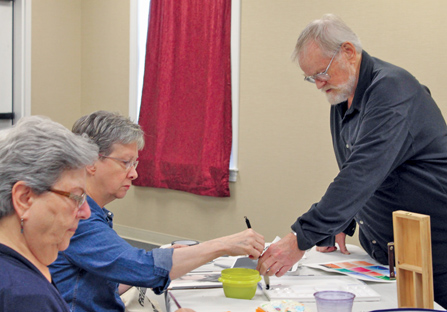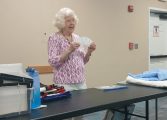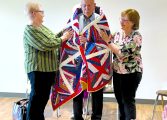By Page H. Gifford, Correspondent
Of all the painting mediums, water mediums seem to perplex artists who are new to it. They lament that the acrylics dry too quickly but that can be remedied with additives. The most challenging issue seems to be watercolor and mastering the skills and techniques. On June 16, artist Troy Weidenheimer gave Fluvanna Art Association members a chance to explore watercolor techniques in part two of his three-part series.
Members were told only to use two colors: black and Tuscan red, a reddish-brown color.
“If you can’t work with one color or even two colors then don’t add any more to your palette,” said Weidenheimer. He then explained he does swatches of colors and even color mixes to see how they interact with one another. He also checks to see which are staining pigments. This is important when correcting mistakes in watercolor because staining pigments cannot be lifted out; like ink, they are permanent. Non-staining pigments can be lifted out easily with a wet brush.
“We are also told not to add black to a color for shadows, but to mix colors,” he said. “Adding black will darken colors, and if you mix two colors, such as crimson red and phthalo green, you will get mud.”
In watercolor, color is built up in layers through gradations of color, and often this can only be achieved successfully if the right tools are applied, including the right support, or paper.
“A good watercolor paper is critical for the absorption of water and lay down of color,” he said. One member asked about the difference between hot and cold pressed watercolor papers, which can be confusing. Weidenheimer explained that the process in cold press creates a rougher paper, usually 300 lb. with more tooth to hold the water and pigment better. Hot press creates a smoother paper with less tooth, usually 140 lb. and some 90 lb. “The heavier the weight the more water it can absorb without buckling.”
“Try a variety of papers and experiment,” Weidenheimer said. He demonstrated the effect certain papers and weights can have on the outcome of watercolor washes. Arches, a favorite among pros, was at the top of Weidenheimer’s list and can be pricey, but serious watercolorists know it is worth the investment. Canson also has papers that are satisfactory for beginners and students.
Brushes were also cited as a critical element of good painting.
“Nylon brushes will eventually fray so go and buy another, but invest in a few expensive brushes,” he said. Watercolor brushes should have flexibility and spring back to their natural shape when dry, whereas acrylic or oil brushes may be more stable to handle heavier body paints.
“I’m into pristine. If the materials and tools are not good – it can make painting difficult,” he said. This was the opening to artists attempting to create lights, darks and soft edges in their workshop exercise. Weidenheimer’s approach was to watch how watercolor behaves, learning to manipulate it through the control of water. With crummy brushes and bad paper it can be frustrating.
A realist when it comes to painting, Weidenheimer encourages the use of reference photos for subjects.
“Most artists use reference photos or objects from life to paint – they cannot always pull from memory,” he said. He is also a stickler for measuring the subject either from life or a photo to get the proportions and angles correct.
“A college art teacher said when students do not measure they are not serious,” Weidenheimer said. He uses a proportional divider which can also be adjusted to enlarge or reduce the size of the subject. He added that those that paint landscapes need to keep in mind the rule of foreground, middle-ground and background. All objects in the foreground are sharp, but as they recede they become softer and more out of focus. This is a common mistake of amateur landscape painters.
The exercises were not as easy as they looked. It takes practice to master the very difficult and tedious process of watercolor. But learning to master the techniques and build skill is a joyful and rewarding experience.





